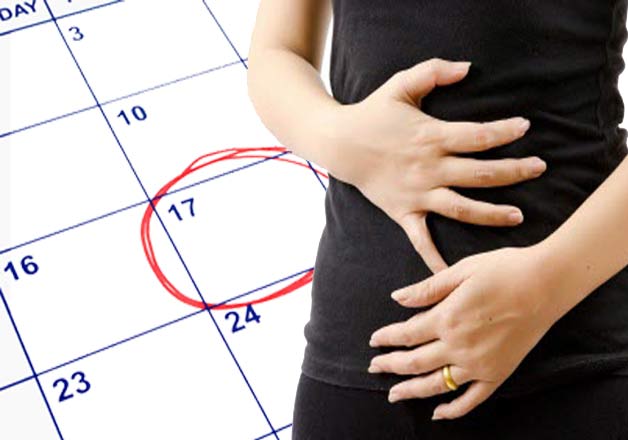Before the onset of menstruation, a woman's uterus changes greatly. It has the property of increasing in size, lowering, and sometimes somewhat rising. Many women feel a tingling sensation in the uterus before menstruation, which often alarms them. Sometimes unpleasant sensations can indicate the development of various diseases, therefore, at the slightest suspicion of pathology, you should consult a doctor and conduct an examination.
Nevertheless, in most cases, changes that occur with the female organ are a variant of the norm, when the tingling is periodic and weakly expressed.

The causes of this pathology
Despite the fact that tingling in the uterus before menstruation can be a natural reaction of the body to the monthly cycle, sometimes their appearance indicates the development of such diseases:
- Endometriosis One of the symptoms of this disease is acute tingling, often combined with dysmenorrhea. Soreness can occur during intercourse or during the act of defecation.
- Dysmenorrhea. Dull or sharp colic that occurs immediately before or during menstruation.
- Inflammatory processes. Sometimes such diseases are accompanied by purulent discharge from the genital tract.
- Ectopic pregnancy. Acute colic in combination with bleeding, may be accompanied by fever and fainting.
- Violation of the location of the appendages. In this case, tingling can be especially pronounced during pregnancy and with an increase in ovaries. This phenomenon is often accompanied by nausea and vomiting.
- Oncological pathologies. With such diseases, tingling and pain may not appear immediately, but only after a while. Tingling is often accompanied by bleeding.
It is not always tingling in the uterus before menstruation. Sometimes it can occur during ovulation and at short gestation. Such sensations, as already mentioned, are not in every case a sign of a disease, but this symptom must be taken seriously, and be checked by a doctor just in case.
Pink discharge before menstruation
Vaginal secretion is one of the prerequisites for the proper functioning of the reproductive system. Normally, before menstruation, the discharge is light, without an admixture of blood and an unpleasant odor. But sometimes women notice the appearance of pink discharge, and this may indicate the development of pathological processes in the body. Pink discharge before menstruation is considered the norm only in the following cases:
- Cleansing of the endometrium, the upper layer of which grows when the egg ripens. Preparation for rejection of this layer can lead to pink discharge.
- Late onset of ovulation. The ovarian follicle ruptures during ovulation and minor pinkish discharge is considered normal. In some cases, ovulation is double - in the middle and near the end of the cycle.
- Features of contraception. If a woman uses hormonal drugs or a spiral, a pink pink discharge that is insignificant in volume before menstruation can talk about the body's adaptation to contraception. In addition, this may be a reaction to the transformation of the hormonal background in connection with taking medications.
- Mechanical damage, for example, active sexual intercourse. This can cause damage to the vessels of the uterus, which leads to staining of the discharge in pink. This happens not only before menstruation, but also on any day of the cycle.
- Pregnancy. A pink mucus may be a sign of the introduction of a fertilized egg into the layers of the uterus.
Pathological causes of pink discharge before menstruation are:
- Hormonal disorders. Such failures lead to the development of hormone-dependent gynecological pathologies.
- Reproductive organ diseases: STDs, tumors (malignant and benign), erosion or endometriosis.
Highlighting pink with an unpleasant odor is an occasion to consult a specialist. If they are observed several days before menstruation constantly, then this suggests that, most likely, the pathological process is sluggish. We will also figure out why there are dark discharge before menstruation.

The appearance before menstruation in women of dark secretions
This symptom is observed in many women a few days before menstruation. Gradually, the discharge intensifies and transforms into full bleeding. This condition is considered normal and does not require medical intervention.
Another thing is if dark discharge before menstruation begins in 5-7 days. Often this symptom indicates the development of inflammatory pathologies of the uterus, erosion, endometrial hyperplasia or the formation of cervical polyps.
Discharges of a brown tint before menstruation can occur due to hormonal malfunction in the body caused by improper use of oral contraceptives.
In the presence of polyps on the cervix or erosion, a woman may also experience the appearance of brown secretions a day before menstruation. The gynecologist can confirm the development of the pathological process when examined in the mirrors. The appearance of pathological discharge is also possible after vaginal douching or rough intercourse, which is caused by trauma to the mucous membrane of the organ.
Often, the appearance of secretions in women before menstruation is due to the use of funds from an unwanted pregnancy, for example, an intrauterine device and a vaginal ring, but most often they occur when taking low-dose oral medications.
Is chest pain normal?
Let's figure out how many days before menstruation, chest pains. The causes of pain in the mammary glands are based on a change in the correctness of the process of production of sex hormones. Ideally, a woman's breasts should not hurt. The severity of such changes, in combination with environmental factors, determines the development of certain pathologies of the mammary glands. Soreness before menstruation can occur in the following cases:
- Mastodynia accompanied by premenstrual syndrome. In addition to chest pains, women, as a rule, also have other complaints (increased blood pressure, headaches, swelling of the legs and arms, psycho-emotional disorders, etc.). In such a situation, the specialist assesses the severity of PMS and prescribes complex therapy, taking into account all the complaints of the patient.
- The response of the body. Under the influence of prolactin and progesterone in the second phase of the cycle, the mammary glands slightly increase due to stagnation of venous blood and edema of the stroma, and women may experience pain in the chest, but it should not last more than 4 days with normal health. When changing the menstrual phases, when the ratio of hormones changes again, the discomfort disappears. In this case, the patient does not need specific treatment.
Many women are concerned about how many days before menstruation, chest pains. Mammologists give this answer: if everything is in order with health, then soreness of the mammary glands occurs 4 days before menstruation. Other options are considered pathology.
Also, women are often interested in what should be the basal temperature before menstruation.

What does basal temperature mean?
The basal chart helps to monitor the correctness of the processes in the body of a woman. Before determining the norm of the basal temperature in the cycle of a particular woman, it should be remembered that measurements must be carried out at least 3-4 months. This will provide the most reliable values. There are some features of the event in this event:
- measurement time - 1 minute - with an electronic thermometer and 5-7 minutes of mercury;
- use the same thermometer;
- the procedure is carried out in the morning, at least after 6 hours of sleep, without getting out of bed and without making sudden movements, at the same time;
- indicators are recorded in a schedule under which deviations in lifestyle are noted (stress, colds, alcohol use, physical stress, etc.).
Possible abnormalities due to an imbalance in hormones or disease are known. The most typical examples of these deviations are:
- Progesterone deficiency, which provokes a decrease in the graph curve. This pathology is characterized by a slow rise in temperature, lasting no more than a week. The difference in values between the phases is less than 0.4 °, the second stage of the cycle is shortened to 10 days, which causes the onset of menstruation. With this pathology, the basal temperature first decreases, then it goes up and remains at this level for about a week.
- Endometritis, which raises the temperature in the early days of menstruation to 37 °. In this case, after a slight decrease before menstruation, instead of falling, an increase in indicators is noted.
- Pregnancy. In this case, the temperature is increased: 37.5 °. Vaginal discharge may be noted, indicating the likelihood of a miscarriage. At high basal temperature and a negative test, an ectopic pregnancy is possible.
- Inflammation of the appendages, which increases the indications in the first phase and in the second. Immediately before menstruation, with this pathology, a temperature of up to 38 ° is noted.
So, what should be the basal temperature before menstruation? It fluctuates within 37 °, after which it should decrease. If this did not happen, then this phenomenon indicates either the onset of conception, or the development of a certain pathology of the genital area.

Increased appetite - is this the norm?
To understand the reason for the manifestation of such unusual symptoms as increased appetite before menstruation, you need to understand the physiology of this process. As scientists have found, the causes of increased appetite are hidden in the cyclical nature of the hormonal background. It is these changes in a certain phase of the cycle that provoke changes in well-being.
It is known that in the premenstrual period, estrogens affect the process of serotonin production. And as their level begins to decrease before menstruation, the production of serotonin also decreases, and this is the reason for an increase in appetite. However, this explanation is too exaggerated, because hormones are not the only source that stimulates the synthesis of the "hormone of happiness." Increased appetite is expressed not only in the need for more food, but in the desire for certain foods - chocolate, pastries, etc. And this can not be explained by a lack of serotonin.
Some scientists believe that this phenomenon lies in a change in the intensity of metabolic processes, which are activated before the onset of menstruation. Active metabolism requires additional energy, so a woman subconsciously seeks to get it from food.
Burning in the intimate area
Such a phenomenon as pain, itching and burning in the intimate area before menstruation is a phenomenon that is familiar to almost every woman. Most often, such manifestations are physiological in nature. Another thing is a pronounced burning sensation that causes discomfort, accompanied by redness, a change in the volume and color of the discharge and other pathological symptoms.
The intimate area is quite sensitive to various changes, especially before menstruation. If the burning sensations are insignificant, this may indicate an increase in the number of secretions, which is typical for preparing the body for menstruation. Often this symptom is the result of external factors, for example, wearing synthetic underwear, bathing in ponds, washing with hygiene products, etc. However, it happens that burning is a sign of a certain disease.
So, the complex of reasons for the development of pain in the uterus before menstruation and burning include:
- Allergic reactions: irritation with latex, artificial materials of linen. This also includes the microflora of the sexual partner, the use of devices for sex, etc.
- Poor hygiene.
- Frequent stresses. Since the psychoemotional state of a woman is reflected in hormonal balance, burning in the intimate zone can be directly related to stressful situations.
- The reaction to the frequent change of sexual partner.
- Immunodeficiency conditions. Before menstruation, a decrease in the immune response is observed, which provokes the development or exacerbation of diseases.
- Sexually transmitted infections. Burning in this case is often accompanied by profuse discharge of a dark color and other symptoms: redness, rashes, etc.
- Thrush and candidal colpitis. A sure symptom of these pathologies is burning in the intimate area and the curdled nature of the discharge. Sometimes the severity of manifestations may subside, but before menstruation, they usually resume.
- The presence of a foreign object in the vagina. They may be particles of poor-quality hygiene products (tampons), devices for intimate proximity, etc.
- Parasitic, herpes, or fungal infections. This is the most common cause of burning before menstruation.
- Taking medications. Burning in the intimate area can provoke antifungal drugs, antibiotics, hormonal and antiviral agents.
- Douching, especially which is done without the recommendation of a doctor.
Uterine size: normal and deviation
We will also tell you what the uterus should be before menstruation. Shortly before the critical days, women note that the stomach is getting larger, in its lower part, heaviness and pressure are felt. The reason for this phenomenon is a change in the size of the uterus. This is a physiological process that does not require treatment, but it can also be triggered by pathological causes. If the enlargement of the uterus occurs due to natural reasons, then it becomes noticeable by the period of the egg's exit - at this time conception is possible.

The size of the uterus before menstruation can change upwards approximately 1 week before the onset of menstruation. In this phase, the level of progesterone in the blood increases, under its influence the body retains fluid. Due to its accumulation in tissues, the uterus continues to grow after ovulation. In the natural course of the cycle, the uterus also increases under the influence of estrogen, which is responsible for the formation of the endometrial layer in the first part of the cycle, and for the accumulation of fluid in the second. With the onset of menstruation, the uterus takes on its usual size. If during this period the organ continues to increase, pregnancy may occur.

There are other factors under the influence of which the uterus can increase before menstruation:
- Myomas are a common cause of uterine enlargement. These are benign tumors that can have various sizes. Tumors develop on the walls of the uterus, can be asymptomatic, but sometimes they provoke the development of pain and severe bleeding.
- Adenomyosis The disease is characterized by the fact that the inner layer of the uterus enters the muscle structure of the organ. During menstruation, muscle tissue begins to secrete blood, causing swelling of the uterus and pain. Adenomyoma is an enlarged section of its wall.
- Polycystic ovary syndrome, which can also provoke an increase in the size of the uterus. The disease is characterized by the development of hormonal failure and cycle disorders. Typically, the endometrial membrane during menstruation completely goes outside, however, with this disease, parts of it may remain inside. So the accumulation of endometrial tissues can cause inflammation and an increase in the uterus.
- Endometrial cancer, one of the signs of which is an enlarged uterus.
- Ovarian cysts. These neoplasms also become the result of malfunctioning hormones, so an increase in the uterus is inevitable.
Within the normal range in women of childbearing age, the uterus has the following dimensions:
- width - no more than 60 mm;
- length - no more than 70 mm;
- wall thickness - not more than 42 mm.
Uterus position
As a rule, the position of the uterus before menstruation does not change. It remains unchanged always, with the exception of pathological conditions in which its bending or dropping develops. Many women note that the uterus lowers before menstruation, but this theory is not confirmed by medicine. , , , . , . «» 70 % .

. , . , .
? , , , . . – , . . , . , . , .
Reinforced uterine contractions and tingling in the uterus before menstruation can occur under the influence of an intrauterine device. Such a contraceptive often causes an increase in back pain before and during menstruation. Thus, there is no escape from such a symptom on the eve of critical days. But what to do? Before menstruation, you can significantly reduce its manifestations and intensity, eliminating excessive physical exertion, or you can take an antispasmodic medication, preferably by prescription.